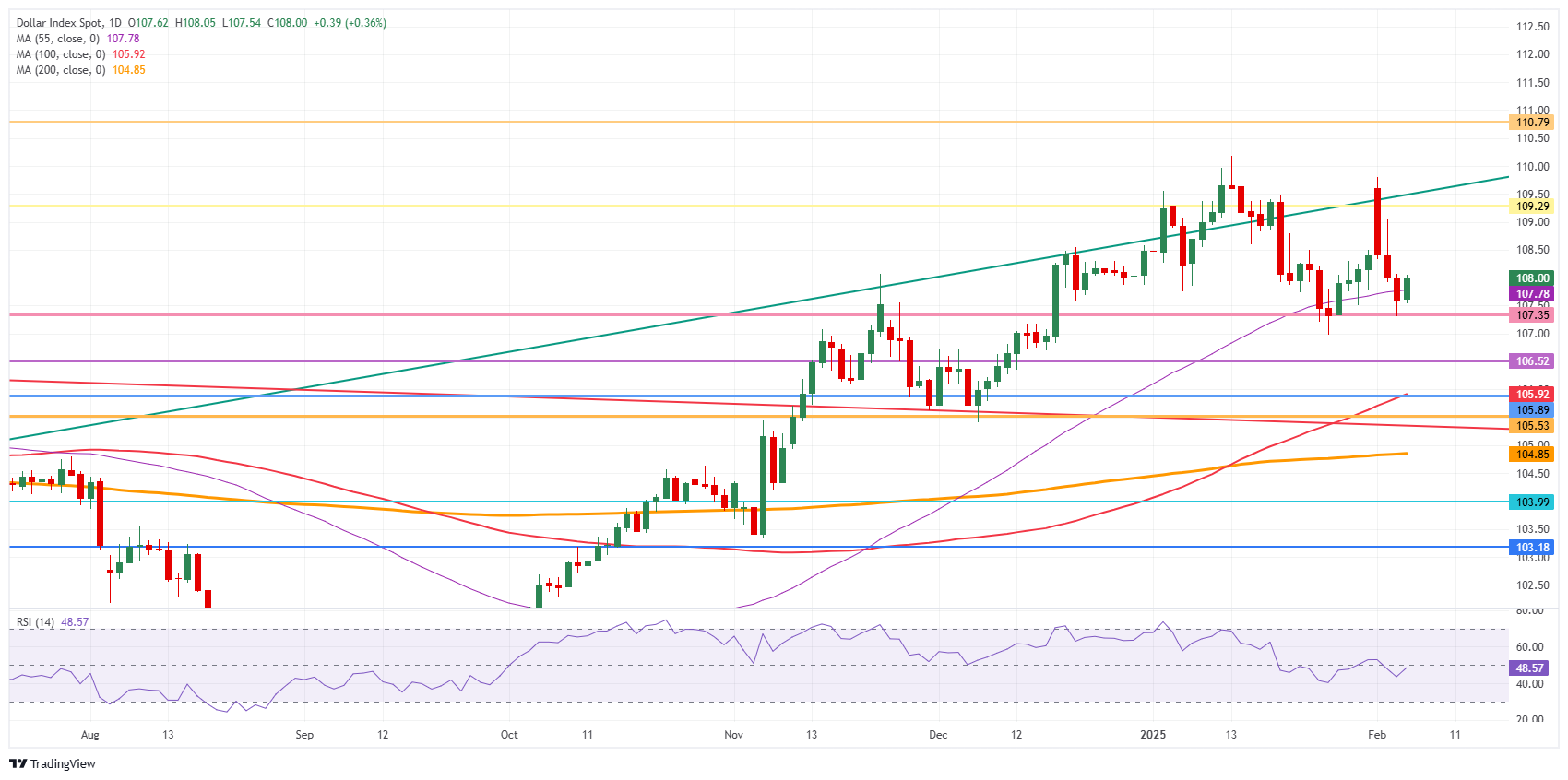US Dollar bounces off support after softening stance from President Trump
- The US Dollar is starting to recover against most major peers in the G10 space.
- US President Trump released some easing comments and remarks, softening the risk-off tone in markets.
- The US Dollar Index (DXY) is trying to pop back above 108.00.
The US Dollar Index (DXY), which tracks the performance of the US Dollar against six major currencies, ticks up in the European trading session on Thursday, trading slightly below 108.00 at the time of writing. The move comes after comments from US President Donald Trump revealing his intentions to take over Gaza and reach a nuclear deal with Iran. Besides that, a plan to end the war in Ukraine will probably be put on the table either this or next week by the Trump administration as well.
On the economic data front, comments from US Treasury Secretary Scott Bessent sparked some support in US yields. Bessent said that the Trump administration wants to bring down 10-year Treasury yields, not the Federal Reserve's (Fed) benchmark short-term interest rate, Bloomberg reports. For this Thursday, the weekly US Jobless Claims are due, ahead of Friday’s Nonfarm Payrolls print.
Daily digest market movers: BoE draws attention
- The Bank of England (BoE) has released its monetary policy decision. As expected a 25 basis point (bps) rate cut was applied to 4.50% from 4.75%. The vote split was 7 in favor for a 25 basis point rate cut against 2 votes for a 50 basis points rate cut.
- At 12:30 GMT, the US Challenger Job Cuts for January are due. No forecast is available, with the previous number at 38,792.
- Fast forward to 13:30 GMT, the US Jobless Claims are due for the week ending January 31.
- Initial Claims are expected to head to 213,000 from 207,000 last week.
- Continuing Claims are set to jump to 1.87 million from 1.858 million.
- At 19:30 GMT, Federal Reserve Governor Christopher Waller participates in a discussion on the future payments at the GeoEconomics Center, hosted by the Atlantic Council in Washington D.C.
- San Francisco Fed President Mary Daly is set to speak as well at 20:30 GMT.
- At 22:10 GMT, Dallas Fed President Lorie Logan speaks on a panel discussion titled "Future Challenges for Monetary Policy in the Americas" at an event in Mexico City.
- Equities are catching a breather on the back of the soothing comments from US President Donald Trump. Across the board, from China over Europe to US Futures, are in the green.
- The CME FedWatch tool projects an 85.5% chance of the Fed keeping interest rates unchanged in the next meeting on March 19.
- The US 10-year yield is trading around 4.45%, recovering from its fresh yearly low at 4.40% printed on Wednesday.
US Dollar Index Technical Analysis: Room for a breather
The US Dollar Index (DXY) is finally breathing a sigh of relief, bouncing off from some technical levels in several major crosses against the US Dollar. Comments from US President Donald Trump and US Treasury Secretary Scott Bessent at least helped to trigger a slight turnaround in the DXY after its past three-day decline. Meanwhile, pressure will build up in the runup to the Nonfarm Payrolls report for January, which will be released on Friday.
On the upside, the first barrier at 109.30 (July 14, 2022, high and rising trendline) was briefly surpassed but did not hold on Monday. Once that level is reclaimed, the next level to hit before advancing further remains at 110.79 (September 7, 2022, high).
On the downside, the October 3, 2023, high at 107.35 has withstood the recent selling pressure. For now, that level still looks to be holding, though watch out for the Relative Strength Index (RSI), which still has some room for the downside. Hence, look for 106.52 (April 16, 2024, high) or even 105.90 (resistance in June 2024 and 100-day Simple Moving Average) as better support levels.

US Dollar Index: Daily Chart
US Dollar FAQs
The US Dollar (USD) is the official currency of the United States of America, and the ‘de facto’ currency of a significant number of other countries where it is found in circulation alongside local notes. It is the most heavily traded currency in the world, accounting for over 88% of all global foreign exchange turnover, or an average of $6.6 trillion in transactions per day, according to data from 2022. Following the second world war, the USD took over from the British Pound as the world’s reserve currency. For most of its history, the US Dollar was backed by Gold, until the Bretton Woods Agreement in 1971 when the Gold Standard went away.
The most important single factor impacting on the value of the US Dollar is monetary policy, which is shaped by the Federal Reserve (Fed). The Fed has two mandates: to achieve price stability (control inflation) and foster full employment. Its primary tool to achieve these two goals is by adjusting interest rates. When prices are rising too quickly and inflation is above the Fed’s 2% target, the Fed will raise rates, which helps the USD value. When inflation falls below 2% or the Unemployment Rate is too high, the Fed may lower interest rates, which weighs on the Greenback.
In extreme situations, the Federal Reserve can also print more Dollars and enact quantitative easing (QE). QE is the process by which the Fed substantially increases the flow of credit in a stuck financial system. It is a non-standard policy measure used when credit has dried up because banks will not lend to each other (out of the fear of counterparty default). It is a last resort when simply lowering interest rates is unlikely to achieve the necessary result. It was the Fed’s weapon of choice to combat the credit crunch that occurred during the Great Financial Crisis in 2008. It involves the Fed printing more Dollars and using them to buy US government bonds predominantly from financial institutions. QE usually leads to a weaker US Dollar.
Quantitative tightening (QT) is the reverse process whereby the Federal Reserve stops buying bonds from financial institutions and does not reinvest the principal from the bonds it holds maturing in new purchases. It is usually positive for the US Dollar.

